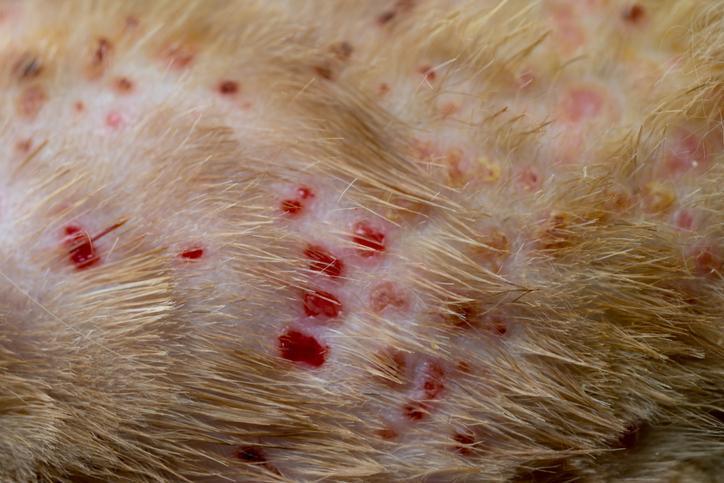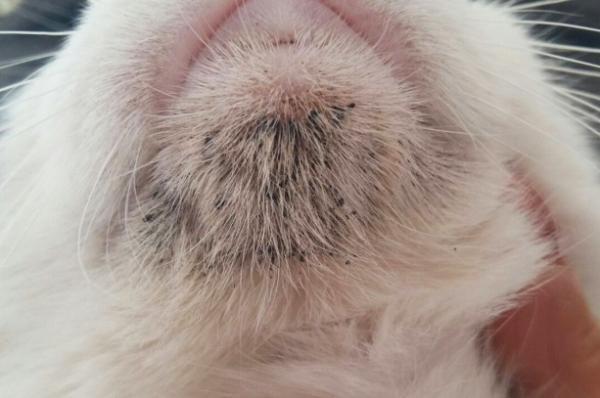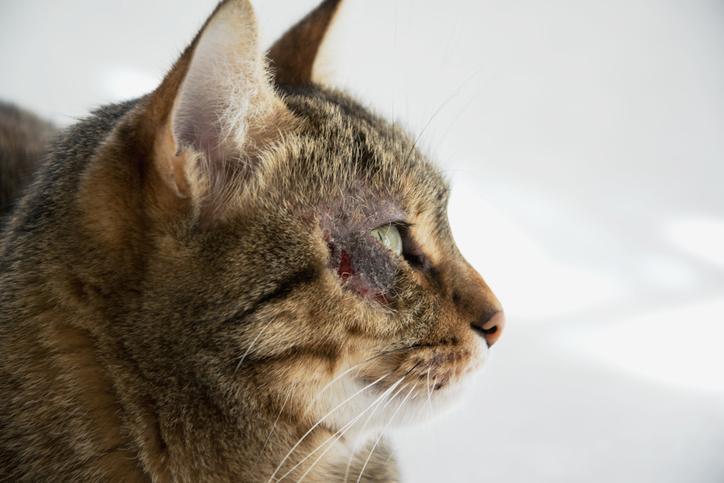Scabs on My Cat - Causes and Treatment

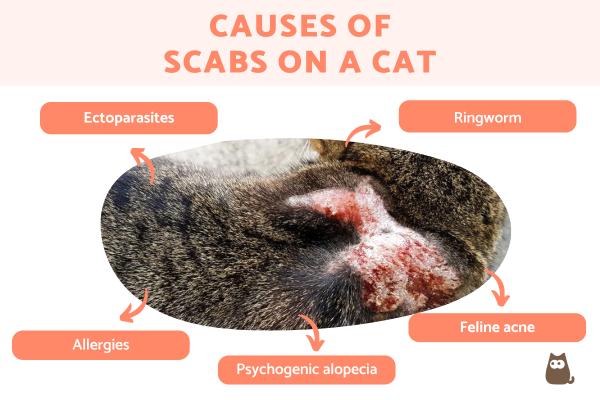

See files for Cats
If you see that you have scabs on your cat, it means their skin has broken and is trying to repair itself. Unless you have a hairless cat, the hair will fall out if the skin breaks in this way. Any reason for hair loss in cats is worrying, but if you see wounds or scabs, there is particular cause for concern. You will have hopefully noticed it at an early stage, but it is possible for some skin conditions in cats to go unnoticed for a prolonged time. This will depend on many factors including the length of a cat's fur and the speed with which the skin problem progresses.
AnimalWised looks into skin conditions in cats by giving you the causes and treatment of these problems. We also provide pictures so you can have an idea of different scabs and how they correlate to different diseases.
Ringworm in cats
Perhaps the most well-known skin condition in cats, ringworm is particularly feared by guardians. Part of the reason is because it is also a skin issue which can be contracted by humans. Contrary to what the name suggests, it is not a worm or parasite, but a type of fungal infection. These fungi create various types of lesions on the skin, the most typical is a rounded shape which looks like a coiled worm. It is usually accompanied by alopecia in cats.
The cat will develop dry flaky skin which look scabby. If they are able to reach the skin, they may scratch the area and cause a wound to develop. The result may be scabs, although it is possible for scabs to form without scratching in acute cases.
Feline ringworm is a particularly common skin condition in kittens. This is because they are more vulnerable and have not yet had the time to develop their resistance. A lowered immunity is the same reason why feral or street cats are more likely to have this condition. Both highlight the importance of maintaining the hygiene of your cat. To diagnose ringworm in cats, a Wood's lamp is used and treatment will require anti-fungal medication.
For more about feline alopecia, take a look at our article on reasons why your cat has hair missing.
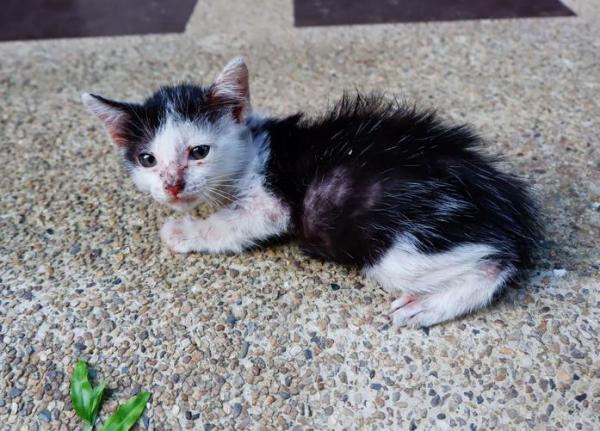
Flea allergy dermatitis
Dermatitis is another cutaneous disease which is a common reason you find a scabby cat. It is also a skin condition in cats which has various types. Flea allergy dermatitis occurs as an allergic reaction to the saliva of fleas. Fleas will cause problems for any cat, but not every feline is specifically allergic. For those which are, even a single bite is enough to cause skin lesions. The cat will scratch the itch caused by the flea bite, meaning the most affected areas are the lumbosacral, perineal, abdominal, flank and neck areas.
The symptoms of flea allergy dermatitis usually intensify during flea season, although we sometimes don't spot them if the reactions are small. To avoid this skin disease in cats, it is essential we stick to a deworming schedule for all the animals in our home. We should also check for fleas when we brush our cat and disinfect shared living areas regularly.
Distribution of different flea bite reactions can differ. Find out more with our article on miliary dermatitis in cats.

Psychogenic alopecia in cats
This is a type of feline skin disease which results from a behavioral disorder. The hair loss is self-induced by excessive licking and grooming. It occurs because the cat is anxious, usually resulting from changes in their environment.
For this reason, a scabby cat could be due to moving into a new home, the arrival of a new family member or any type of stressor. Alopecia (hair loss) can appear anywhere on the body its mouth can reach. In these cases, the treatment will stem from the cause of stress. If we cannot work out why the psychogenic alopecia is occurring, we can contact a feline ethologist.
When the cat grooms so much, they may cause the skin to break and develop wounds which may scab over. You will need to take the cat to the vet to both help discover the cause and to treat any wounds. Since human antiseptic can be toxic to cats[1], the vet should provide a feline friendly antiseptic.

Feline acne
Acne is associated with teenagers and feline acne has its kitty equivalent. Although it can occur at any age, it most commonly presents after the cat reaches sexual maturity. It presents with an inflammation under the shin, but can also appear on the lips. At the beginning there are black spots which can progress to pustules, infections, edema, enlargement of the nodes and acute itching. Many symptoms occur due to the complications of a secondary infection.
There is little understanding of the exact causes of feline acne. From a collated study of reports in 2003, several factors have been hypothesized including “poor grooming habits of individual cats, abnormal sebum production, hair cycle abnormalities, localized keratinization defect, stress, viral infections, immunosuppression, and allergies”[2] may be at fault. Treatment will be prescribed by the veterinarian and will consist of topical treatment.
A complication of feline acne is the contact of the cat's chin with their feeding bowls. Plastic feeding bowls are believed to exacerbate feline acne and may even be a cause, so use good quality metal or ceramic feeding and water bowls.
Imagen: socialrescate.wixsite.com
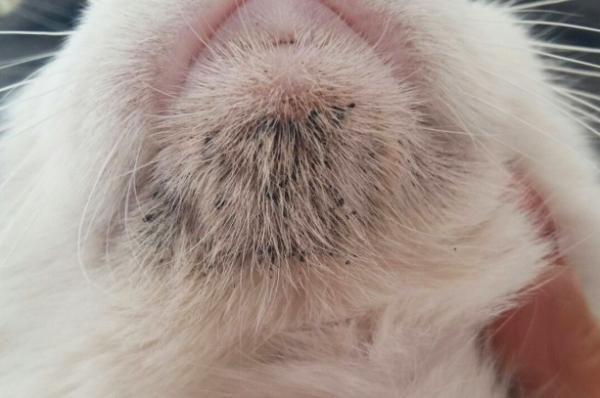
Atopy in cats
Atopy is a term for hypersensitivity to different allergens that cause skin disease in cats. It is characterized by inflammation and itching of the skin which is known as atopic dermatitis. It usually appears in younger cats under the age of three. Its symptomatology is varied, but usually presents with signs of alopecia and open wounds where the dry skin breaks. Pruritus may result which means pus will be present. The combination of open wounds and pus will lead to various types of scabs, but none of them can be ignored.
Some cats suffering from atopic dermatitis may also have a respiratory problem which presents as a chronic cough, sneezing and maybe even conjunctivitis. Treatment is based on finding ways to control the itching. Atopic dermatitis is difficult to prevent as it is believed there is a core genetic element element at fault.
Solar dermatitis in cats
This skin condition in cats is caused by exposure to sunlight. It affects areas of the skin with less hair or even hairless areas as these parts are more exposed to the sun. The areas around the ears, nose, eyelids and lips are all particularly vulnerable. It will begin with hair loss, redness and skin peeling. If the exposure continues it will become acute and wounds and scabs appear. These lead to pain and scratching from the cat which can complicate the clinical picture.
In the case of the ears, tissues is lost and can generate into a squamous cell carcinoma, a form of malignant tumor. Avoid direct contact with the sun and use protection for hairless cats in the form of sun block and/or clothing.
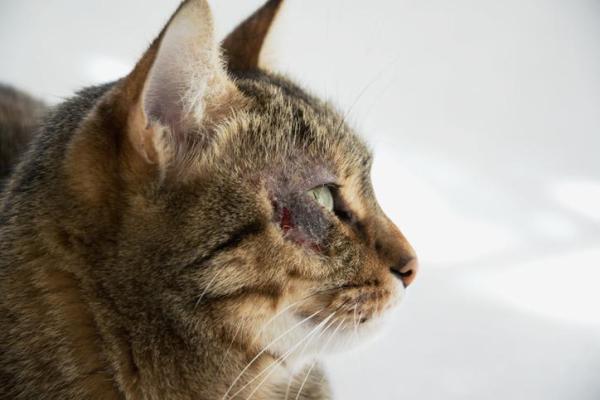
Fibrosarcoma associated with injections
Occasionally, both injections for vaccination or intravenous medical treatment can trigger a neoplastic process. This is due to the irritants which these products may contain. In these feline skin condition, inflammation occurs at the injection site. This may lead to a subcutaneous mass which is not painful to the touch, but can lead to hair loss weeks and months after the injection.
As a type of malignant sarcoma, fibrosarcoma will need surgical removal. If the disease progresses, it may ulcerate leading to scabs. Unfortunately, the prognosis is not always good with this type of tumor and we need to be very careful. It is important to keep an eye on the injection site after your cat gets any type of injection.
Skin conditions in Persian cats
All the previous skin diseases mentioned in this article can affect any cat. However, due to their breed characteristics and genetic history, Persian cats are particularly prone to certain skin diseases. In the Persian cat breed, the following skin conditions stand out:
- Hereditary seborrhea: this can occur to a mild or intense degree. The mild form appears after 6 weeks of age. It occurs in the skin at the root of the hair. The follicle becomes infected and pimples occur. It is particularly abundant around the ears. Intense seborrhea can be seen after only 3 to 4 days of life and results in skin peeling, scabs and a foul odor. For treatment, anti-seborrheic shampoos are used.
- Idiopathic facial dermatitis: this is believed to be caused by a disorder of the sebaceous glands. It is characterized by a dark secretion that forms crust around the eyes, mouth and nose in young cats. The clinical picture is complicated by infections, itching of the face and neck and, frequently, otitis (ear inflammation). The treatment involves anti-inflammatory drugs and control of the symptoms.

Home remedies for cat scabs
We have provided the most common causes of skin conditions in cats which result in scabs. Such causes are diverse, being influenced by factors such as genetics, diet, hygiene, environment and care the cat receives. With this in mind, we can look at the home remedies we can use to prevent scabs in cats:
- Diet: ensure you provide the cat with the correct diet for their specific needs. This means amending the type and quantity of food according to their age and health status, among other factors.
- Hygiene: cats are naturally hygienic animals. Despite this, it will be much more difficult to control their hygiene if they live in a dirty environment. Ensure their litter box is cleaned regularly and provide clean water every day. This will help to avoid the spread of parasites and bacteria which can lead to scabs on the cat.
- Exercise: cats need exercise to stay healthy. This means we need to provide them with plenty of opportunity for physical activity, especially if they are an exclusively indoor cat. Play with them regularly and create spaces in the home for them to move around.
- Deworming: even if they are indoor cats, we need to ensure we establish a suitable deworming routine. This will avoid the parasites specific to your area and prevent external parasites causing cat scabs.
- Vaccination: similarly to deworming, cats need to establish a vaccination schedule to prevent the diseases which are prevalent in your area. Doing so can save the cat's life, especially if they interact with other cats.
As you can see, these are general home remedies for cat scabs which will help prevent relate skin conditions from developing. In terms of treatment, each cause of scabs in cats will need to be diagnosed and prescribed treatment by a qualified veterinarian. Never use home remedies on a cat without prior consultation with your veterinarian.

This article is purely informative. AnimalWised does not have the authority to prescribe any veterinary treatment or create a diagnosis. We invite you to take your pet to the veterinarian if they are suffering from any condition or pain.
If you want to read similar articles to Scabs on My Cat - Causes and Treatment, we recommend you visit our Skin problems category.
1. Mahdi, A., & Van der Merwe, D. (2013). Dog and cat exposures to hazardous substances reported to the Kansas State Veterinary Diagnostic Laboratory: 2009-2012. Journal of medical toxicology: official journal of the American College of Medical Toxicology, 9(2), 207–211. https://doi.org/10.1007/s13181-013-0289-8
https://www.ncbi.nlm.nih.gov/pmc/articles/PMC3657027/
2. Scott, D. W., & Miller, Jr., W. H. (2010). Feline Acne: A Retrospective Study of 74 Cases (1988–2003). Jpn J Vet Dermatol, 16(4), 203–209.
https://www.jstage.jst.go.jp/article/jjvd/16/4/16_4_203/_pdf



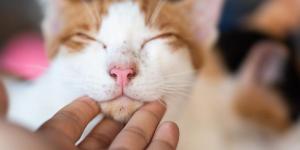


 My cat Kitty has had flea and wormer and antibiotic injection from Vet ,but she still suffers with itchy scabs and bald patches can you advise treatment please!
My cat Kitty has had flea and wormer and antibiotic injection from Vet ,but she still suffers with itchy scabs and bald patches can you advise treatment please!



